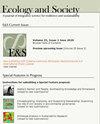走向绿色的荆棘之路:绿色和蓝色基础设施规划、实施和管理中的意外后果、权衡和限制
IF 3.6
2区 社会学
Q1 ECOLOGY
引用次数: 20
摘要
城市绿地和蓝色空间干预可能会带来意想不到的后果,涉及不同土地用途之间的权衡,甚至不同城市居民、土地使用者和所有者的需求之间的权衡。这种权衡包括在绿色/蓝色和非绿色/蓝色项目之间的选择,在更广泛的土地节约与土地共享模式之间的选择、在满足不同居民的需求之间的选择以及在安排绿色和蓝色空间的不同方式之间的选择。我们通过一组预定义的问题来分析六个与绿色和蓝色基础设施(GBI)相关的案例研究城市的投资和规划举措——这是一个基于以下假设的分析框架,即GBI向城市居民和其他利益相关者的利益流是由三个过滤器介导的:基础设施、制度和观念。本文建立在作者自己对所分析的案例研究城市及其他城市的知识和经验、文献综述、对相关城市文件的回顾以及对关键信息者的采访的基础上。案例研究表明了旨在让城市居民能够获得GBI福利的举措示例,承认GBI是具有多种功能的空间。一些案例研究提供了在密集建成区为多个私人和公共利益规划和设计绿地时进行权衡的例子。意外后果通常是由于对社会生态系统复杂性的低估,更具体地说,是对相关基础设施、制度和观念复杂性的低估。论文中提出的最重要的挑战包括在满足居民与生态系统服务利益相关的不同需求的不同方式之间进行权衡,确保对居民需求和看法的适当认识,生态绅士化,与非正式空间形式化相关的注意事项,以及需要考虑在不同地理尺度上折衷不同目标的时间动态和跨尺度方法。本文章由计算机程序翻译,如有差异,请以英文原文为准。
The thorny path toward greening: unintended consequences, trade-offs, and constraints in green and blue infrastructure planning, implementation, and management
Urban green and blue space interventions may bring about unintended consequences, involving trade-offs between the different land uses, and indeed, between the needs of different urban inhabitants, land users, and owners. Such trade-offs include choices between green/blue and non-green/blue projects, between broader land sparing vs. land sharing patterns, between satisfying the needs of the different inhabitants, but also between different ways of arranging the green and blue spaces. We analyze investment and planning initiatives in six case-study cities related to green and blue infrastructure (GBI) through the lens of a predefined set of questions—an analytical framework based on the assumption that the flows of benefits from GBI to urban inhabitants and other stakeholders are mediated by three filters: infrastructures, institutions, and perceptions. The paper builds on the authors' own knowledge and experience with the analyzed case-study cities and beyond, a literature overview, a review of the relevant city documents, and interviews with key informants. The case studies indicate examples of initiatives that were intended to make GBI benefits available and accessible to urban inhabitants, in recognition of GBI as spaces with diverse functionality. Some case studies provide examples of trade-offs in trying to plan and design a green space for multiple private and public interests in densely built-up areas. The unintended consequences most typically resulted from the underappreciation of the complexity of social–ecological systems and—more specifically—the complexity of the involved infrastructures, institutions, and perceptions. The most important challenges addressed in the paper include trade-offs between the different ways of satisfying the residents' different needs related to the benefits from ecosystem services, ensuring proper recognition of the inhabitants' needs and perceptions, ecogentrification, caveats related to the formalization of informal spaces, and the need to consider temporal dynamics and cross-scale approaches that compromise different goals at different geographical scales.
求助全文
通过发布文献求助,成功后即可免费获取论文全文。
去求助
来源期刊

Ecology and Society
环境科学-生态学
CiteScore
6.20
自引率
4.90%
发文量
109
审稿时长
3 months
期刊介绍:
Ecology and Society is an electronic, peer-reviewed, multi-disciplinary journal devoted to the rapid dissemination of current research. Manuscript submission, peer review, and publication are all handled on the Internet. Software developed for the journal automates all clerical steps during peer review, facilitates a double-blind peer review process, and allows authors and editors to follow the progress of peer review on the Internet. As articles are accepted, they are published in an "Issue in Progress." At four month intervals the Issue-in-Progress is declared a New Issue, and subscribers receive the Table of Contents of the issue via email. Our turn-around time (submission to publication) averages around 350 days.
We encourage publication of special features. Special features are comprised of a set of manuscripts that address a single theme, and include an introductory and summary manuscript. The individual contributions are published in regular issues, and the special feature manuscripts are linked through a table of contents and announced on the journal''s main page.
The journal seeks papers that are novel, integrative and written in a way that is accessible to a wide audience that includes an array of disciplines from the natural sciences, social sciences, and the humanities concerned with the relationship between society and the life-supporting ecosystems on which human wellbeing ultimately depends.
 求助内容:
求助内容: 应助结果提醒方式:
应助结果提醒方式:


